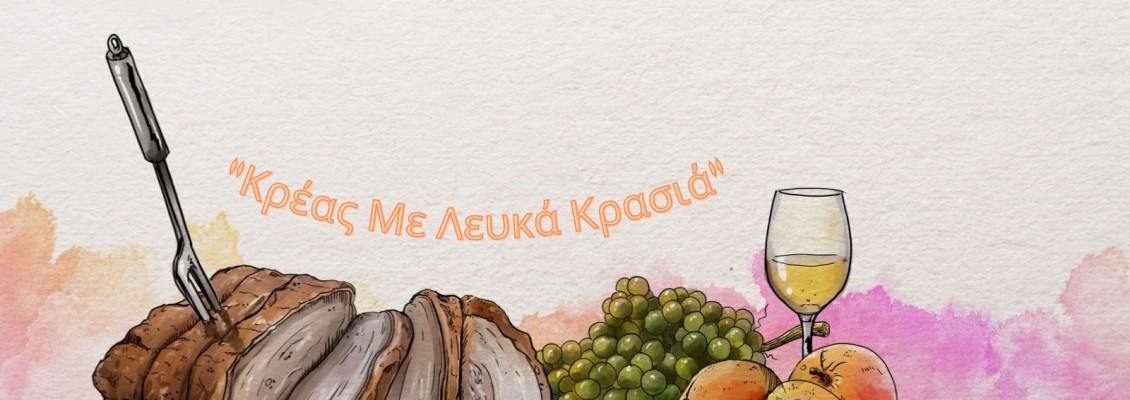Does meat pair with white wine? | Stavros Moustakas Oktapodas DipWSET

We were taught to only pair meat with red wine.
Let's forgive them!
Some will talk about stereotypes, others about
"common sense", others simply don't drink red wine because it annoys
them, while there are also those who don't mind pouring white wine into their
glass when they have a juicy steak in front of them.
Do we have a problem? Of course not!
As you surely understood, today we will talk about the
pairing of all kinds of meat with white wines.
First things first: why our initial thought is red?
The main reasons are, of course, the tannins (that is, the astringent feeling
in the mouth) since they have the ability to combine with the protein of the
meat and make the result more balanced. Add to the equation the (usually) rich
body of barrel-aged red wines, and you have a recipe for success.
But can we find these characteristics in white wines as well? The answer is yes, and here are the main parameters the wine must have:
- Tannins: But do white varieties have tannins? It depends on the variety itself, and how thick and phenolic the grape is, but also on the way of vinification. A typical example here is Assyrtiko, which always gives wines with a slightly (or strongly) tanic sense, while techniques in the winery such as extraction (that is, what we also do in red wines to get colour and tannins) or passing through new barrels are able to make the desired sensation of tannins
- Body: or in other words the full and "thick" sensation in the mouth, which is essential to food pairing, especially in the presence of full sauces. Full-bodied varieties like Assyrtiko (we'll get bored talking about it today), Vidiano, or barrel-aged Chardonnay proudly meet this criterion.
- Acidity: how sour the wine is, will also play it’s part, especially for fatty meats: Assyrtiko, Robola, Moschofilera, Kydonitsa, even white ... Xinomavro are the most suitable here, along with international varieties such as lots of Chardonnay, Sauvignon Blanc and Riesling.
- Bubbles: for the same reason, that is to "cut" the fat of the meat, you can combine the acidity with the bubbles of a good sparkling wine, in a two-in-one package!
But let's look together at the main scenarios that we
will meet at our table:
- A well-done ribeye: Here we have fat and a meat full of richness, which suits perfectly with a classic barrel aged Chardonnay. In fact, if your steak has been cooked in a pan with butter, the variety is a one-way road, since it is similar to the winemaking technique called malolactic conversion, which brings out butter aromas. Bingo! Try the Muses EstateChardonnay Fume or the Aivalis Chardonnay which will do the job well, while a mature Vidiano such as Aspros Lagos Douloufakis or Ippodromos Lyrarakis will also stand up beautifully.
- Casserole with lemon sauce: It doesn't get more Greek and mother-like, and here the pairing of acidity/body will play the most important role: the coach will pour a unoaked Assyrtiko to the first eleven of the team, along with co-players Assyrtiko of Akrathos Winery or one of the many wonderful Santorinis such as Ampelones Vassalti Santorini, while from the bench to change the flow of the match in the second half, Kefalonia will come with Robola Gentilini.
- Lamb/Goat: Forgive me for being dogmatic here, but white wines are the absolute choice, even if the conversation involves … red wines. Santorini is an obvious choice again. Opt for an unoaked label if your meat is in the oven or pot, and a barrel aged label if we're talking about barbequed ribs or traditional Greek rotisserie. Alternatively, throw some rosemary on the coals, and elevate the experience with a premium Retsina like Vryniotis Estate's recently reborn PDO Gialtra label. If you are a fan of sparkling wines, you will have a great time here, with the closest thing to a top Champagne, the Estate Karanikas Brut Cuvée Prestige from Assyrtiko and Xinomavro.
- Chicken: Alright, here white is the natural choice, but the secret is the cooking method and the sauces. Go for something light with a medium body when you go to a roast or casserole, like Moschofilero and Mantineia Moropoulou, and switch to something fuller when you have white sauces, like Palivos Estate Viognier.
- Pork: Similar to beef, only here we usually have a "sweeter" approach, which is further enhanced by sauces, being sometimes quite sweet themselves. In this last "Christmas" occasion, prefer a wine that will also have a slightly sweet palette to balance, such as Nopera Eran Winery's Muscat. If the meat is without sweet sauces, Kydonitsas like the one from Oenops Wines, but also orange versions due to their developed aromatic character, such as Ni (MiNiMus Series) by Chloe Hatzivaritis, go well with it.
Cheers!
Stavros Moustakas OKtapodas DipWSET
About the Editor:
Stavros Moustakas-Oktapodas DipWSET has worked as a
wine consultant for a large Greek import company and in addition, in strategic
and communication positions for Greek wineries
He holds the WSET Diploma, which completed with honors, with two international scholarships (best overall performance and best performance in the blind taste test exams for the academic years 2016 and 2017).
He has been a judge at the Thessaloniki International
Wine Competition, the largest European competition Concours Mondial de
Bruxelles, and is a contributor to Oinochoos magazine.